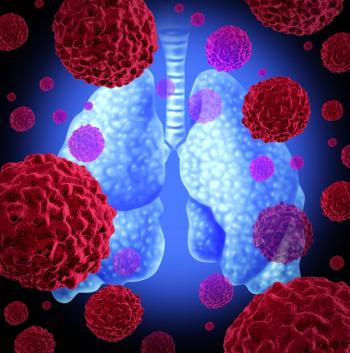
- ONCOLOGY Vol 11 No 9
- Volume 11
- Issue 9
The Radiologic Appearance of Lung Cancer
The article by O'Donovan discusses the radiologic appearance of lung cancer, with particular emphasis on the radiographic appearance and work-up of solitary pulmonary nodules (SPNs).
The article by O'Donovan discusses the radiologic appearance of lung cancer,with particular em
phasis on the radiographic appearance and work-up of solitary pulmonary
nodules (SPNs).
The pages devoted to the diagnosis of solitary pulmonary nodules arecomprehensive and thorough. They include discussions of rate of growthand doubling times, CT densitometry, CT contrast enhancement, the appearanceand significance of calcification within pulmonary nodules, and nodulemargins, as well as the presence and diagnostic significance of cavitation.The use of PET scanning for diagnosis of solitary pulmonary nodules isbriefly discussed.
In my own clinical practice at a cancer center where the incidence ofmalignant pulmonary nodules is considerably higher than at other institutions,I find that an emphasis on the patient's history (particularly a historyof smoking, or possibly of other occupational exposures) and, most importantly,the availability of prior chest radiographs for comparison, are the mostimportant factors in distinguishing benign from malignant solitary pulmonarynodules, prior to histologic confirmation.
Although I was a contributor to one of the early papers on nodule densitometry,this technology has fallen into disuse. The study is moderately complicated,and, unless performed frequently, it becomes somewhat unfamiliar. In addition,the evaluation of nodular density without resorting to cumbersome phantomtechnology has become more reliable with modern CT scanners.
Similarly, the margins of the lesion, presence of cavitation and theamount and distribution of calcium (unless calcification within the nodulehas clearly benign characteristics) within nodules are, at best, highlyrelative indicators of benignity or malignancy, necessitating confirmationby other means. It may well be that the percentage of solitary pulmonarynodules in which there is a true diagnostic dilemma is actually quite smallthepresence of a new nodule in a smoker or a patient with a history of malignancynecessitates histologic confirmation. A solitary pulmonary nodule in apatient from an area with endemic infectious processes that cause nodulesalso requires further evaluation. A nodule that has not changed size in2 or more years is presumed to be benign.
Use of PET Scanning
In the last several years, PET has become available at some centersto evaluate patients in whom there is a significant possibility that thenodule may be benign. In these patients, a negative PET scan would stronglysuggest benignity, with simple radiographic follow-up advised. For patientswith abnormal increased uptake of FDG on PET scanning, histologic diagnosisis necessary, even though there is a discrete possibility that the histologymay ultimately prove to be benign. Unfortunately this technology is notuniversally available and requires expensive equipment as well as geographicproximity to a cyclotron for production of the short-lived radionuclidesused in this procedure.
In summary, my own emphasis would be on the clinical history (most importantly,cigarette smoking), the availability of old chest x-rays for comparison,and, if significant doubt persists, the use of PET scanning, followed byhistologic diagnosis.
I found the discussion of the varying radiographic appearances of differenthistologic varieties of lung cancer enlightening. From a clinical pointof view, as a practicing radiologist, I tend to focus on the staging oflung cancer, including both noninvasive imaging (CT, PET scan) and invasiveprocedures (percutaneous biopsy, mediastinoscopy, bronchoscopy). In addition,the impact of staging procedures on therapeutic choices merits scrutiny.The relative strengths and weaknesses of CT have been extensively investigated,with indications of high accuracy in determining extent of local disease(T-stage), as well as deficiencies (with an overall accuracy of no morethan 70%) in correctly diagnosing mediastinal lymphadenopathy.
It appears quite possible that PET scanning may well alleviate someof these deficiencies in the detection of mediastinal nodal disease, withsuggested overall accuracy in the 85% to 90% range. In addition, it hasbeen indicated that PET scanning may be useful for locating unsuspecteddistant metastatic (M1) disease. Although these claims are still unconfirmedby large cooperative clinical trials, there appears to be some reason forcautious optimism concerning the use of PET scanning in the pretherapeuticstaging of lung cancer.
The relative merits of various forms of invasive staging, as well astheir limitations (for example, the inability of mediastinoscopy to sampleall mediastinal lymph nodes) would go beyond the scope of an imaging review.Nevertheless, we can be grateful to this author for his succinct and comprehensivediscussion of the presentation of lung cancer, including solitary pulmonarynodules.
Articles in this issue
over 28 years ago
UFT: East Meets West in Drug Developmentover 28 years ago
Rationale for Phase I Study of UFT Plus Leucovorin and Oral JM-216over 28 years ago
Postoperative Adjuvant Chemotherapy for Non-Small-Cell Lung Cancerover 28 years ago
UFT in Gastric Cancer: Current Status and Future Developmentsover 28 years ago
Oral UFT and Leucovorin in Patients With Advanced Gastric CarcinomaNewsletter
Stay up to date on recent advances in the multidisciplinary approach to cancer.































































































